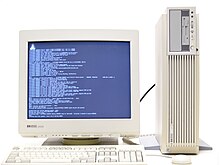
Back حوسبة دقيقة بمجموعة تعليمات مخفضة Arabic PA-RISC Czech PA-RISC German PA-RISC Esperanto PA-RISC Spanish PA-RISC Finnish PA-RISC French PA-RISC Hungarian PA-RISC ID PA-RISC Italian
 | |
| Designer | Hewlett-Packard |
|---|---|
| Bits | 64-bit (32→64) |
| Introduced | 1986 (1996 PA-RISC 2.0) |
| Version | 2.0 (1996) |
| Design | RISC |
| Encoding | Fixed |
| Branching | Compare and branch |
| Endianness | Big |
| Extensions | Multimedia Acceleration eXtensions (MAX), MAX-2 |
| Open | No |
| Successor | PA-WideWord → Itanium[1] |
| Registers | |
| General-purpose | 32 |
| Floating point | 32 64-bit (16 64-bit in PA-RISC 1.0) |


Precision Architecture RISC (PA-RISC) or Hewlett Packard Precision Architecture (HP/PA or simply HPPA), is a general purpose computer instruction set architecture (ISA) developed by Hewlett-Packard from the 1980s until the 2000s.
The architecture was introduced on 26 February 1986, when the HP 3000 Series 930 and HP 9000 Model 840 computers were launched featuring the first implementation, the TS1.[2][3] HP stopped selling PA-RISC-based HP 9000 systems at the end of 2008 but supported servers running PA-RISC chips until 2013.[4] PA-RISC was succeeded by the Itanium (originally IA-64) ISA, jointly developed by HP and Intel.[5]
- ^ "Inventing Itanium: How HP Labs helped create the next-generation chip architecture". HP Labs. 1 June 2001. Archived from the original on 7 February 2002. Retrieved 24 March 2024.
- ^ "One Year Ago". (26 February 1987). Computer Business Review.
- ^ Rosenbladt, Peter (September 1987). "In this Issue" (PDF). Hewlett-Packard Journal. 38 (9): 3. Archived (PDF) from the original on 26 April 2019. Retrieved 8 June 2018.
... In the March 1987 issue we described the HP 3000 Series 930 and HP 9000 Model 840 Computers, which were HP's first realizations of HP Precision Architecture in off-the-shelf TTL technology. ...
- ^ "How long will HP continue to support HP 9000 systems?". Archived from the original on 19 February 2012. Retrieved 29 February 2008.
- ^ "HP Completes Its PA-RISC Road Map With Final Processor Upgrade". Archived from the original on 13 February 2008. Retrieved 24 July 2007.